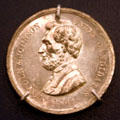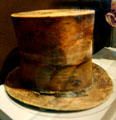CHILDHOOD
- Feb. 12, 1809: Abraham Lincoln born to Thomas Lincoln & Nancy Hanks in a one room log cabin at Sinking Spring farm near Hodgenville, KY.
- Spring, 1811: Due to deed problems, Thomas Lincoln moves family ten miles to rented farm on Knob Creek.
- December, 1816: The Lincoln family moves to Indiana to obtain free land.
|


|
NEW SALEM
- 1831: Abe settles in New Salem, Illinois; works as a clerk in the village store.
- 1832: New Salem village store goes out of business. Lincoln & partner William Berry purchase another store which fails a year later.
- Aug. 6, 1832: Lincoln loses first campaign for Illinois House of Representatives.
|

 |
EARLY ILLINOIS POLITICS & LAW
- Aug. 4, 1834: Lincoln elected to Illinois General Assembly as a Whig & begins study of law.
- Aug. 1, 1836: Lincoln re-elected.
- Sept. 9, 1836: Lincoln gets license to practice law.
- 1837: Lincoln moves from New Salem to Springfield as city replaces Vandalia as Illinois state capital.
- 1837: Becomes law partner of John T. Stuart.
- Aug. 6, 1838: Lincoln re-elected & becomes Whig floor leader.
- 1839: Lincoln becomes a circuit rider of United States Circuit Court.
- June 1840: Lincoln argues his first case before the Illinois Supreme Court.
- Aug. 3, 1840: Lincoln re-elected to fourth term.
- March 1, 1841: Lincoln becomes law partner with Stephen T. Logan & decides not to stand for re-election to state legislature.
|



 |
MARRIAGE
- 1839: Lincoln meets Mary Todd, 21.
- Fall 1840: Lincoln is engaged to Mary Todd but breaks it off Jan. 1, 1841, only to resume mid 1842.
- Nov. 4, 1842: Lincoln marries Mary Todd in Springfield.
|

|
- May, 1844: Lincoln moves family including infant son Robert Todd Lincoln into Springfield house.
- March 10, 1846: Edward Baker Lincoln is born, but dies February 1, 1850.
- Dec. 21, 1850: William (Willie) Wallace Lincoln is born.
- April 4, 1853: Thomas (Tad) Lincoln is born.
|

|
NATIONAL POLITICS & LAW
- 1843: Lincoln fails in try for Whig nomination for U.S. Congress.
- 1844: Lincoln campaigns for Henry Clay for president.
- Dec., 1844: Lincoln dissolves law partnership with Logan, to create own practice.
- Aug. 3, 1846: Lincoln elected to U.S. House of Representatives as Whig.
- 1847: Lincoln family moves to Washington, D.C. for 30th Congress, takes seat Dec. 6.
- 1848: Lincoln campaigns for Zachary Taylor for president, Whig party, including speaking tour in New England.
- March 31, 1849: Lincoln family returns to Springfield where Lincoln quits politics to practice law.
- 1850: Lincoln resumes circuit riding for 8th Judicial Circuit & gains reputation as "Honest Abe".
- 1854: To oppose the Kansas-Nebraska Act, Lincoln re-enters politics & is elected to Illinois legislature, but declines seat to try for U.S. Senate.
- 1855: Lincoln not chosen by the Illinois legislature as U.S. Senator & starts helping to organize new Republican party of Illinois.
|




|
REPUBLICAN POLITICS, ANTISLAVERY SPEECHES & LINCOLN-DOUGLAS DEBATES
- May 29, 1856: At first Republican convention, Lincoln gets 110 votes for vice-presidential nomination, gaining national notice.
- 1856: Lincoln campaigns for Republican presidential candidate, John C. Fremont.
- June 26, 1857: Lincoln speaks against Dred Scott slave ownership decision.
- May, 1858: Lincoln wins acquittal in a murder trial by using almanac's moonlight data to discredit a witness.
- June 16, 1858: Lincoln nominated at Republican state convention in Springfield as Illinois senate candidate (against Democrat Stephen A. Douglas) & delivers "House Divided" speech. Lincoln goes on to debate Douglas in seven meetings, causing his national fame.
- November 2, 1858: Illinois legislature selects Douglas for U.S. Senate by 54 votes over Lincoln's 46.
- Sept. 16 - Oct. 5, 1859: Lincoln makes speaking tour of Indiana, Ohio & Wisconsin.
- Fall 1859: Lincoln makes his last trip through 8th Judicial Circuit.
- Nov. 30 - Dec. 7, 1859: Lincoln makes speaking tour of Kansas.
- Dec. 20, 1859: Lincoln writes a short autobiography.
- Feb. 27, 1860: Lincoln gives famous Cooper Union speech in New York City.
- Feb. 28 - March 10, 1860 : Lincoln delivers political speeches on slavery in New England.
- March, 1860: Lincoln-Douglas Debates published.
|





|
LINCOLN RUNS FOR PRESIDENT
- May 18, 1860: Lincoln becomes Republican nominee for president with running mate Hannibal Hamlin against Democrat Stephen A. Douglas.
- June 1860: Lincoln publishes a longer autobiography.
- Nov. 6, 1860: Lincoln wins election as first Republican president, defeating three other candidates.
- Dec. 20, 1860: Lincoln's election precipitates South Carolina secession from the Union, followed within two months by Mississippi, Florida, Alabama, Georgia, Louisiana & Texas.
- Feb. 11, 1861: Lincoln gives a brief farewell to supporters at Springfield rail depot & travels to Washington, eventually guarded by Pinkerton after assassination plot discovered.
- March 4, 1861: Lincoln takes oath of office as 16th U.S. president & states he has no plans to end slavery.
|







|
LINCOLN & CIVIL WAR
- April 12, 1861: Civil War begins as Confederates open fire on Fort Sumter in Charleston.
- 1861: Civil War goes badly for the Union. Lincoln has trouble controlling Generals.
- Feb. 20, 1862: Lincoln's son Willie dies. Mrs. Lincoln is devastated & never recovers.
- Jan. 1, 1863: Lincoln issues Emancipation Proclamation freeing all slaves in territories held by Confederates.
- July 3, 1863: Confederates defeated at Battle of Gettysburg, turning point in the Civil War.
- Nov. 19, 1863: President Lincoln delivers Gettysburg Address at ceremony dedicating the Battlefield as a national cemetery.
- May, 1864: General Ulysses S. Grant is promoted to commander of the Union armies.
- June 8, 1864: Lincoln is nominated for president, Andrew Johnson for Vice-President, by coalition of Republicans & War Democrats.
- Nov. 8, 1864: Lincoln is re-elected president, defeating Democrat George B. McClellan, a former General who had ignored Lincoln's orders & been removed from command March, 1862.
- March 4, 1865: Lincoln's inauguration ceremonies in Washington.
- March 24, 1865: Lincoln with Mary & Tad visits Grant at front line Union headquarters at City Point, VA.
- April 4, 1865: Lincoln visits Union commanders in Richmond, VA, two days after the city's surrender.
- April 9, 1865: Gen. Robert E. Lee surrenders Confederate army to Gen. Ulysses S. Grant at Appomattox Court House in Virginia.
|












|
DEATH OF LINCOLN
- April 14, 1865: Lincoln & Mary attend play "Our American Cousin" at Ford's Theater. About 10:13 pm, John Wilkes Booth shoots Lincoln in the head. Doctors move Lincoln to a house across the street. He never regains consciousness.
- April 15, 1865: 7:22 in the morning, President Abraham Lincoln dies.
- April 21 - May 3, 1865: A funeral train carries Lincoln from Washington, DC to Springfield, IL with stops for public viewings in Baltimore, Harrisburg, Philadelphia, New York City, Albany, Buffalo, Cleveland, Columbus, Indianapolis & Chicago. It is estimated that well over a million Americans turned out at these events.
- May 4, 1865: Abraham Lincoln is laid to rest in Oak Ridge Cemetery, Springfield, Illinois after lying in state in the Illinois Hall of Representatives where he started his political career.
- Nation builds monuments to Abraham Lincoln, one of its most honored Presidents.








|







|








